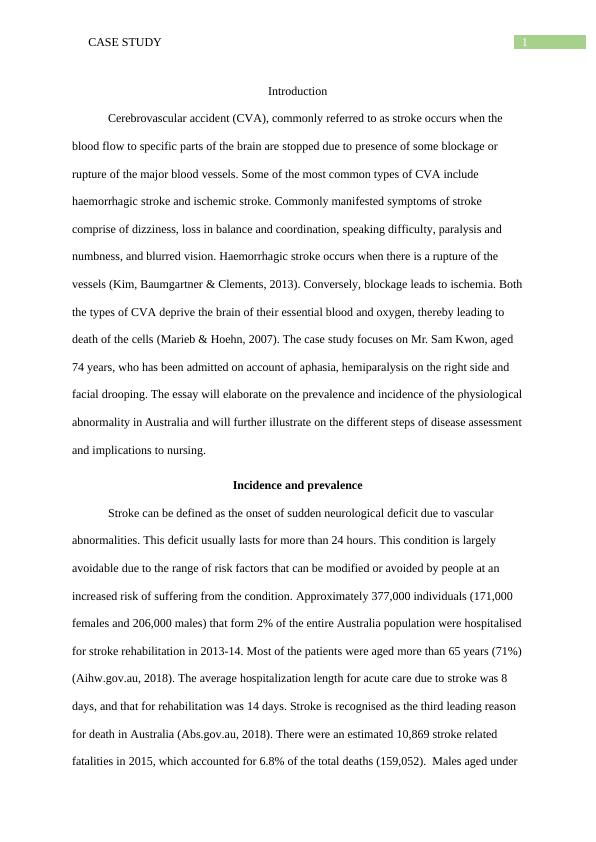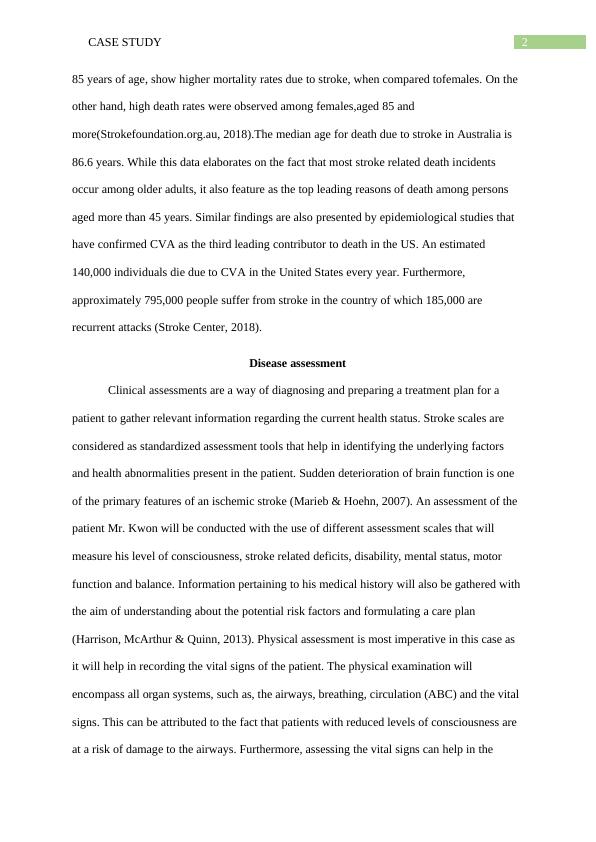Case Study on Cerebrovascular Accident
Added on 2021-06-17
9 Pages2758 Words80 Views
Running head: CASE STUDYCerebrovascular accidentName of the StudentName of the UniversityAuthor Note

1CASE STUDYIntroductionCerebrovascular accident (CVA), commonly referred to as stroke occurs when the blood flow to specific parts of the brain are stopped due to presence of some blockage or rupture of the major blood vessels. Some of the most common types of CVA include haemorrhagic stroke and ischemic stroke. Commonly manifested symptoms of stroke comprise of dizziness, loss in balance and coordination, speaking difficulty, paralysis and numbness, and blurred vision. Haemorrhagic stroke occurs when there is a rupture of the vessels (Kim, Baumgartner & Clements, 2013). Conversely, blockage leads to ischemia. Boththe types of CVA deprive the brain of their essential blood and oxygen, thereby leading to death of the cells (Marieb & Hoehn, 2007). The case study focuses on Mr. Sam Kwon, aged 74 years, who has been admitted on account of aphasia, hemiparalysis on the right side and facial drooping. The essay will elaborate on the prevalence and incidence of the physiologicalabnormality in Australia and will further illustrate on the different steps of disease assessmentand implications to nursing. Incidence and prevalenceStroke can be defined as the onset of sudden neurological deficit due to vascular abnormalities. This deficit usually lasts for more than 24 hours. This condition is largely avoidable due to the range of risk factors that can be modified or avoided by people at an increased risk of suffering from the condition. Approximately 377,000 individuals (171,000 females and 206,000 males) that form 2% of the entire Australia population were hospitalisedfor stroke rehabilitation in 2013-14. Most of the patients were aged more than 65 years (71%)(Aihw.gov.au, 2018). The average hospitalization length for acute care due to stroke was 8 days, and that for rehabilitation was 14 days. Stroke is recognised as the third leading reason for death in Australia (Abs.gov.au, 2018). There were an estimated 10,869 stroke related fatalities in 2015, which accounted for 6.8% of the total deaths (159,052). Males aged under

2CASE STUDY85 years of age, show higher mortality rates due to stroke, when compared tofemales. On the other hand, high death rates were observed among females,aged 85 and more(Strokefoundation.org.au, 2018).The median age for death due to stroke in Australia is 86.6 years. While this data elaborates on the fact that most stroke related death incidents occur among older adults, it also feature as the top leading reasons of death among persons aged more than 45 years. Similar findings are also presented by epidemiological studies that have confirmed CVA as the third leading contributor to death in the US. An estimated 140,000 individuals die due to CVA in the United States every year. Furthermore, approximately 795,000 people suffer from stroke in the country of which 185,000 are recurrent attacks (Stroke Center, 2018). Disease assessmentClinical assessments are a way of diagnosing and preparing a treatment plan for a patient to gather relevant information regarding the current health status. Stroke scales are considered as standardized assessment tools that help in identifying the underlying factors and health abnormalities present in the patient. Sudden deterioration of brain function is one of the primary features of an ischemic stroke (Marieb & Hoehn, 2007). An assessment of the patient Mr. Kwon will be conducted with the use of different assessment scales that will measure his level of consciousness, stroke related deficits, disability, mental status, motor function and balance. Information pertaining to his medical history will also be gathered withthe aim of understanding about the potential risk factors and formulating a care plan (Harrison, McArthur & Quinn, 2013). Physical assessment is most imperative in this case as it will help in recording the vital signs of the patient. The physical examination will encompass all organ systems, such as, the airways, breathing, circulation (ABC) and the vital signs. This can be attributed to the fact that patients with reduced levels of consciousness are at a risk of damage to the airways. Furthermore, assessing the vital signs can help in the

End of preview
Want to access all the pages? Upload your documents or become a member.
Related Documents
Prevalence and Risk Factors of Cardiovascular Attacks: A Case Study Analysislg...
|13
|2582
|243
Understanding Stroke Care - CVA Assignment PDFlg...
|14
|4598
|134
Understanding Stroke Carelg...
|6
|1449
|1
Exploration of a Pathophysiology Caselg...
|8
|2386
|201
Cerebrovascular Accident in Australialg...
|12
|3532
|37
Understanding Stroke Care: Types, Symptoms, Diagnosis, and Rehabilitationlg...
|12
|4125
|208
